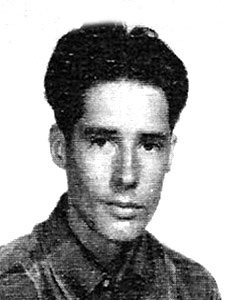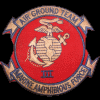"On 14 June 1970, a team from Company E, 1st Reconnaissance Battalion fought the battalion's most severe patrol action of the year. The team, identified by its radio call sign "Flakey Snow," consisted of five enlisted Marines, a corpsman, and two South Korean Marines assigned to the patrol as members of a combined allied reconnaissance training program. Helicopters inserted the patrol at 1122 on the 10th in the southwestern Cue [sic] Sons about five miles west of FIB Ryder. Although deep in the mountains, "Flakey Snow's" first area of operations was a level region with no jungle canopy, but a secondary growth of small trees, bushes, bamboo, and sharp-edged elephant grass. The team's arrival was unopposed, and it moved northward from its landing zone along a wide trail that showed signs of recent, heavy use. After about an hour of uneventful walking, the Marines crossed a small stream and turned eastward on an intersecting trail. This trail, also obviously well traveled, ran toward a hill where the patrol leader, Sergeant Frank E. Diaz, planned to spend the night.
"Clouds closed in and heavy rain was falling. About 1220, Diaz called a halt along the trail to wait until the rain stopped. There the Marines heard heavy machine gun and automatic weapons fire. Although no bullets seemed to be coming toward them, the members of "Flakey Snow" formed a defensive perimeter with only the elephant grass for cover, and quietly readied their weapons. As they did, two Viet Cong, both armed with AK-47s, came walking up the trail, "right into us," Diaz recalled. The Marines shot and killed both of them, but the firing gave away their position. Diaz at once reported by radio that his team was in contact.
"Contact quickly became heavy. From positions north, east, and west of the Marines, an enemy unit, later estimated to have been at least 50 men, opened fire with 12.7mm machine guns and automatic weapons. The Marines, with their backs to the stream they had just crossed, hugged the ground and returned fire with M16s and their one M79 grenade launcher. Whether the enemy was a counter-reconnaissance unit or simply a large force encountered by chance was never established, but it was obvious that they were determined to overwhelm "Flakey Snow." "They really wanted to get us," Diaz reported later, "for whatever reason they had in mind." The enemy began rushing the Marine position in groups of three and four, firing and throwing grenades. Some closed to within 30 feet of the Marines before being cut down. Bodies piled up in front of the patrol. Diaz had his men pull two or three of the closest into a barricade. One American Marine was mortally wounded and another was hit in the shoulder by grenade fragments. A Korean received a severe leg wound. "All this time," Diaz recalled, "we could hear people moaning and groaning on both sides .... The enemy just kept coming, and we just kept shooting and shooting."
"Diaz had called for an aerial observer, and an OV-10 arrived over the patrol at 1245. The aircraft at once began strafing the enemy positions, causing some secondary explosions and more "loud crying and moaning." At 1300, Cobra gunships arrived on station and added their machine guns and rockets to Marine firepower. The closeness of the enemy to "Flakey Snow" prevented use of artillery, but according to Diaz the gunships were "really accurate and a great help in getting us all out of there." In spite of this punishment, the determined enemy hung on. Their fire slackened as the helicopters made their strafing passes, but then resumed.
"At 1345, CH-46s from HMM-263 arrived to extract the team, but the wounded could not be hoisted out. The pilot of one of the Sea Knights, Major Peter E. Benet, executive officer of HMM-263, managed to land close to the team, with the nose of his aircraft hanging over the stream and the rear wheels on the bank. Benet's copilot, 1st Lieutenant Peter F. Goetz, reported that as the helicopter settled in, "we had to cut down through the elephant grass with our blades, the elephant grass was so high."
"Diaz at first thought that the helicopter had been shot down. Then he saw the tailgate opening and began moving his men toward it while he and the reconnaissance battalion extraction officer, who had jumped out of the gate with a rifle, covered the withdrawal. Under continuing enemy fire, the reconnaissance Marines scrambled on board carrying their injured and dying. A few enemy tried to rush the withdrawing team, but Diaz and the extraction officer gunned them down. Lieutenant Goetz, monitoring the helicopter's radios, saw another enemy "pop up, right about our 11 o'clock, with an AK .... It was really fortunate that one of the Cobras was passing over us at the time and spotted him and blasted him with some rockets."
"At 1353, the helicopter lifted off with all members of "Flakey Snow." Diaz and his men had only a magazine of ammunition left between them and a single M79 round; the helicopter crew had expended all the ammunition from their two .50-caliber machine guns. At the price of one American Marine dead of wounds, another slightly wounded, and a South Korean Marine severely injured, "Flakey Snow" had killed at least 18 enemy in front of the patrol's position. An unknown number of enemy had been killed or wounded farther away, either by small arms and grenades, or by OV-10 and helicopter guns and rockets. Sergeant Diaz reported that "the firefight was so intense, and the fire was coming from so many directions, that the enemy themselves had killed their own people, trying to get to us.""
From pp 309-310,
U.S. Marines in Vietnam
Vietnamization and Redeployment
1970-1971
Cosmas and Murray,
History and Museums Division,
Headquarters, U.S. Marine Corps, Washington, D.C.
1986





